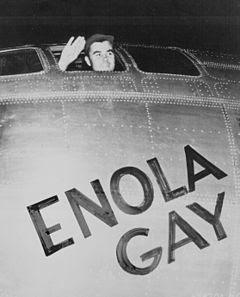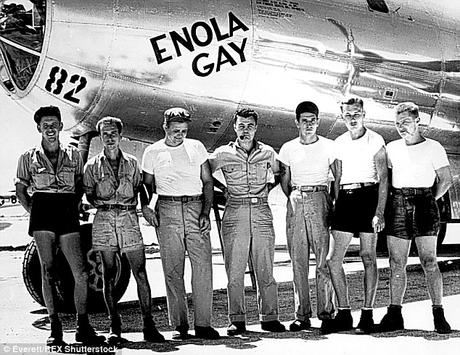 In the 1980s, the Smithsonian began
restoring the Enola Gay - Over the years
it had been disassembled, spread across multiple buildings, birds had nested in
its engines, a turret had been smashed, its wheels had decayed, and its parts
were corroded from being left out in the wind, sun and rain. Yet, workers
invested an estimated 300,000 hours on the task, sorting through countless
parts and polishing its aluminum skin until the iconic B-29 Superfortress — one
of the most (in)famous planes in the world — once more took shape.
It is a Boeing B-29 Superfortress
bomber, named ‘Enola Gay’afterthe mother of the pilot, Colonel Paul Tibbets,
who selected the aircraft while it was still on the assembly line. 70 years
ago, on6th August 1945, during the final stages of World War II, it
became the first aircraft to drop an atomic bomb. The bomb, code-named
"Little Boy", targetted the city ofHiroshima, Japan, and caused
unprecedented destruction. Enola Gay participated in the second atomic attack
as the weather reconnaissance aircraft for the primary target of Kokura. Clouds
and drifting smoke resulted in Nagasaki being bombed instead.
Paul Warfield Tibbets, Jr. (1915 –
2007), was a brigadier general in the United States Air Force. He was the pilot who flew the Enola Gay that dropped Little Boy, the first atomic bomb used
in warfare, on the Japanese city of Hiroshima.
In the 1980s, the Smithsonian began
restoring the Enola Gay - Over the years
it had been disassembled, spread across multiple buildings, birds had nested in
its engines, a turret had been smashed, its wheels had decayed, and its parts
were corroded from being left out in the wind, sun and rain. Yet, workers
invested an estimated 300,000 hours on the task, sorting through countless
parts and polishing its aluminum skin until the iconic B-29 Superfortress — one
of the most (in)famous planes in the world — once more took shape.
It is a Boeing B-29 Superfortress
bomber, named ‘Enola Gay’afterthe mother of the pilot, Colonel Paul Tibbets,
who selected the aircraft while it was still on the assembly line. 70 years
ago, on6th August 1945, during the final stages of World War II, it
became the first aircraft to drop an atomic bomb. The bomb, code-named
"Little Boy", targetted the city ofHiroshima, Japan, and caused
unprecedented destruction. Enola Gay participated in the second atomic attack
as the weather reconnaissance aircraft for the primary target of Kokura. Clouds
and drifting smoke resulted in Nagasaki being bombed instead.
Paul Warfield Tibbets, Jr. (1915 –
2007), was a brigadier general in the United States Air Force. He was the pilot who flew the Enola Gay that dropped Little Boy, the first atomic bomb used
in warfare, on the Japanese city of Hiroshima.
 After the war, the Enola Gay returned
to the United States, where it was operated from Roswell Army Air Field, New
Mexico. It was flown to Kwajalein for the Operation Crossroads nuclear tests in
the Pacific. Later it was transferred to the Smithsonian
Institution, and spent many years parked at air bases exposed to the weather
and souvenir hunters, before being disassembled and transported to the Smithsonian's
storage facility at Suitland, Maryland, in 1961. In the 1980s, attempts were
made to put the aircraft on display, leading to an acrimonious debate about
exhibiting the aircraft without a proper historical context. The cockpit and
nose section of the aircraft were exhibited at the National Air and Space
Museum (NASM) in downtown Washington, D.C., for the bombing's 50th anniversary
in 1995, amid a storm of controversy. Since 2003, the entire restored B-29 has
been on display at NASM's Steven F. Udvar-Hazy Center. The last survivor of its
crew, Theodore Van Kirk, died on July 28, 2014, at the age of 93.
On 5 August 1945, during preparation
for the first atomic mission, Tibbets assumed command of the aircraft and named
it after his mother, Enola Gay Tibbets, who had herself been named for the
heroine of a novel. The name was painted on the aircraft on 5 August by Allan
L. Karl, an enlisted man in the 509th. Hiroshima was the primary target of the
first nuclear bombing mission on 6 August, with Kokura and Nagasaki as
alternative targets. Enola Gay, piloted by Tibbets, took off from North Field,
in the Mariana Islands, about six hours' flight time from Japan, accompanied by
two other B-29s, The Great Artiste, carrying instrumentation, and a
then-nameless aircraft later called Necessary Evil, commanded by Captain George
Marquardt, to take photographs. The director of the Manhattan Project, Major
General Leslie R. Groves, Jr., wanted the event recorded for posterity, so the
takeoff was illuminated by floodlights. Tibbets reportedly even leaned out the window
and waved for the cameras.
The great disaster – the mindless
killing of mankind, went as planned at 08:15 (Hiroshima time) went as planned,
and the Little Boy took 43 seconds to fall from the aircraft flying at 31,060
feet (9,470 m) to the predetermined detonation height about 1,968 feet (600 m)
above the city. Enola Gay traveled 11.5 mi (18.5 km) before it felt the shock
waves from the blast. The detonation
created a blast equivalent to 16 kilotons of TNT. The radius of total destruction was about one
mile (1.6 km), with resulting fires across 4.4 square miles (11 km2). Americans
estimated that 4.7 square miles (12 km2) of the city were destroyed. Japanese
officials determined that 69% of Hiroshima's buildings were destroyed and 70,000–80,000 people, or some 30% of the
city's population, were killed by the blast and resultant firestorm, and
another 70,000 injured.
The return to base of Enola Gay was
celebrated with fanfare. Tibbets was the
first to disembark, and was presented with the Distinguished Service Cross on
the spot. The killings were to continue – Hiroshima was to be followed by
another disaster - originally scheduled for 11 August, it was brought forward
by two days to 9 August owing to bad weather.
There were critics of the planned
exhibit of Enola Gay too. It brought o
global attention many long-standing academic and political issues related to
retrospective views of the bombings. Sad, that so many people were killed and
the killers and killings are being
celebrated as part of history.
With regards – S.
Sampathkumar
After the war, the Enola Gay returned
to the United States, where it was operated from Roswell Army Air Field, New
Mexico. It was flown to Kwajalein for the Operation Crossroads nuclear tests in
the Pacific. Later it was transferred to the Smithsonian
Institution, and spent many years parked at air bases exposed to the weather
and souvenir hunters, before being disassembled and transported to the Smithsonian's
storage facility at Suitland, Maryland, in 1961. In the 1980s, attempts were
made to put the aircraft on display, leading to an acrimonious debate about
exhibiting the aircraft without a proper historical context. The cockpit and
nose section of the aircraft were exhibited at the National Air and Space
Museum (NASM) in downtown Washington, D.C., for the bombing's 50th anniversary
in 1995, amid a storm of controversy. Since 2003, the entire restored B-29 has
been on display at NASM's Steven F. Udvar-Hazy Center. The last survivor of its
crew, Theodore Van Kirk, died on July 28, 2014, at the age of 93.
On 5 August 1945, during preparation
for the first atomic mission, Tibbets assumed command of the aircraft and named
it after his mother, Enola Gay Tibbets, who had herself been named for the
heroine of a novel. The name was painted on the aircraft on 5 August by Allan
L. Karl, an enlisted man in the 509th. Hiroshima was the primary target of the
first nuclear bombing mission on 6 August, with Kokura and Nagasaki as
alternative targets. Enola Gay, piloted by Tibbets, took off from North Field,
in the Mariana Islands, about six hours' flight time from Japan, accompanied by
two other B-29s, The Great Artiste, carrying instrumentation, and a
then-nameless aircraft later called Necessary Evil, commanded by Captain George
Marquardt, to take photographs. The director of the Manhattan Project, Major
General Leslie R. Groves, Jr., wanted the event recorded for posterity, so the
takeoff was illuminated by floodlights. Tibbets reportedly even leaned out the window
and waved for the cameras.
The great disaster – the mindless
killing of mankind, went as planned at 08:15 (Hiroshima time) went as planned,
and the Little Boy took 43 seconds to fall from the aircraft flying at 31,060
feet (9,470 m) to the predetermined detonation height about 1,968 feet (600 m)
above the city. Enola Gay traveled 11.5 mi (18.5 km) before it felt the shock
waves from the blast. The detonation
created a blast equivalent to 16 kilotons of TNT. The radius of total destruction was about one
mile (1.6 km), with resulting fires across 4.4 square miles (11 km2). Americans
estimated that 4.7 square miles (12 km2) of the city were destroyed. Japanese
officials determined that 69% of Hiroshima's buildings were destroyed and 70,000–80,000 people, or some 30% of the
city's population, were killed by the blast and resultant firestorm, and
another 70,000 injured.
The return to base of Enola Gay was
celebrated with fanfare. Tibbets was the
first to disembark, and was presented with the Distinguished Service Cross on
the spot. The killings were to continue – Hiroshima was to be followed by
another disaster - originally scheduled for 11 August, it was brought forward
by two days to 9 August owing to bad weather.
There were critics of the planned
exhibit of Enola Gay too. It brought o
global attention many long-standing academic and political issues related to
retrospective views of the bombings. Sad, that so many people were killed and
the killers and killings are being
celebrated as part of history.
With regards – S.
Sampathkumar
4th Aug 2015.

